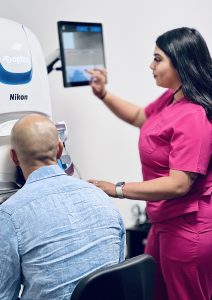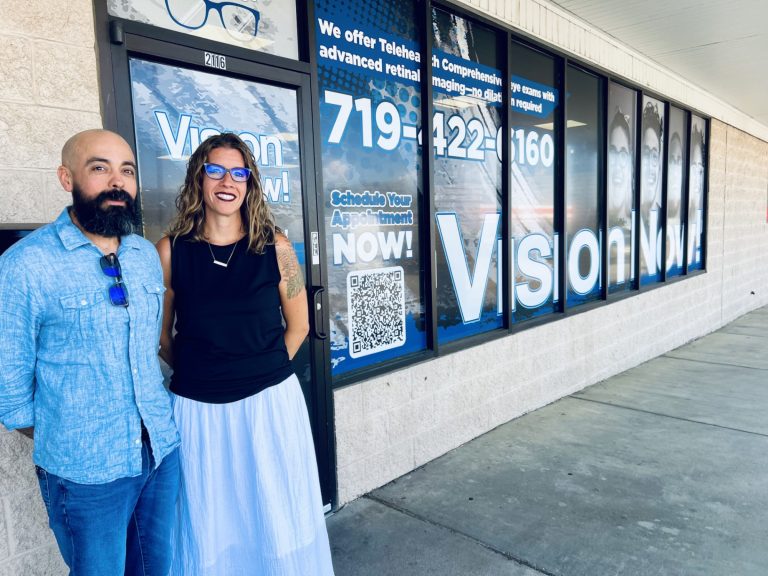T’Naus Nieto
The Chronicle-News
‘There’s just a shortage of doctors that might not want to move to rural locations. We’re adapting to a newer generation, leveraging the technology that exists,’ says co-founder
Since the COVID-19 pandemic and the lack of Medicaid reimbursement in low-income areas, rural healthcare services have faced reductions in services, with some even facing closures. For instance, Rocky Mountain Eye Center’s Trinidad location shut its doors in July 2024, with other clinics fighting to avoid a similar fate.
However, Vision Now, a newer optometry center which took occupation at the former RMEC in Trinidad, with a clinic that recently opened in La Junta around three years ago, promised to bring ‘cutting-edge’ optometry services to their rural locations, addressing a ‘critical shortage,’ and allowing people access to the full optometry services without having to travel long distances.
The clinic claimed to not only be resilient to the fluctuations in reimbursement rates, offering 0% interest membership program, but was able to capitalize on modern technology and an in-house crafted telehealth system, which enabled doctors to provide full scope optometry many miles away and provide real-time feedback with video display of the patient’s eye.
“The problem that we are solving in rural communities is the critical shortage of eye doctors,” Vision Now co-founder Michael Herrera told The Chronicle-News. “Lack of eye doctors means people are either driving to cities or not getting the eye care they need. Eye care is especially critical for senior citizens dealing with eye disease and kids with undiagnosed vision problems. We see about one in four kids who need glasses. A lot of kids don’t see an eye doctor regularly, especially in low-income areas and rural communities. And unsurprisingly, there is a strong correlation with lower educational outcomes in these communities.”
“Our company is committed to making eyecare services and eyewear accessible to everyone by offering a blend of both traditional in-person eye care and cutting-edge tele-optometry.”
Technology

“So, you would walk into the optometry practice, just like you would on any other visit. The pretesting, which is the testing you would do before seeing a doctor, is the exact same. We are blessed with modern technology that allows us to do the examination with the doctor outside of the room in any location without it being a different experience other than I can’t shake your hand,” Doctor Cameran Drake said in an interview.
However, one benefit of the remote model, according to representatives of the clinic, is that optometrists are able to control network equipment, which analyzes a patient’s eye, and provide real-time visual feedback of what the doctor is seeing, all remotely, using a tablet.
Herrera explained, “The big difference here is when a patient comes in, they can see a live picture of the inside of their eye, they can see the video of what the doctor is looking at. We can put a picture on the screen of your eyeball and the doctor and point out what they’re seeing.”
Drake added, “Not only are we doing almost anything that I could do in person, now as a patient, you can see the front of the eye, the back of the eye, instead of me just telling you. The patient can stay at their home location and still receive a comprehensive eye exam, and most treatments can still be provided in-house, even without a physical doctor on-site. So, the patient is less inconvenienced, with us being able to provide that care in their hometown.”
“Our model doesn’t require a doctor to be on-site,” Herrera said. “We use digital diagnostic equipment and telecommunications to allow a doctor to provide comprehensive vision care remotely. In both La Junta and Trinidad, we have a doctor who only needs to travel to these sites once or twice a month.”
Drake said, when asked about those who may have reservations, “The majority of what we do is astronomical compared to what people may think… I have colleagues who know they can treat dry eye or glaucoma with the right equipment, yet they still have to refer [patients] out. So, we’ve created (a model) where we don’t have to refer anything that we’re comfortable with.”
According to Herrera, Vision Now introduced numerous additional capabilities to its rural locations, including a wide selection of eyewear and contact lenses.
However, one of the most prominent pieces of technology that Vision Now offers is a low-light laser device that reduces the amount of drusen in a patient, which helps treat dry eye or macular degeneration.
Drake said, “It’s in a box, right now. We’re going to start using it soon. It’ll be off-label treatment for macular degeneration. We can use the device to treat dry eye, which has been found to lower macular degeneration… It’s off-label use, which is how most medicine comes to fruition anyway. It’s anti-wrinkle too.”
Rural southeast healthcare landscape
Rocky Mountain Eye Center not only had a clinic in Trinidad, but also Raton, N.M., Alamosa, Pueblo, and more, and had closed its doors for all of its locations at the end in 2024 following bankruptcy, which the company cited was due to strain brought on by the COVID-19 pandemic.
As previously reported, Salud Family Health, which has a clinic in Trinidad, also cited the COVID-19 pandemic as a significant factor for its ‘severe’ financial strain due to the lack of Medicaid payments, which the organization needed to fund its operations. CEO John Santistevan, however, has made strides to save the clinics over the past two years, even managing to help pass Colorado legislation that may help fund its clinics and keep their doors open for the near future.
Arkansas Valley Regional Medical Center in La Junta ended its obstetric services earlier this year, and also cited the lack of Medicaid funding, along with low birth rates, as the primary reasons for the closing of the service, at the dismay of those in Arkansas Valley, many of whom were born, or had family born in the hospital.
On June 25 of this year, citing rising costs and low reimbursement rates, the La Junta hospital announced it was cutting some of its staff, prompting the City of La Junta to comment, saying, “The City of La Junta is deeply saddened by the news of recent staff reductions at Arkansas Valley Regional Medical Center. Our thoughts are with the dedicated professionals and families affected by these changes… In this challenging time, our priority remains (for) the health and resilience of our community.”
Researchers at the University of North Carolina also listed the Arkansas Valley Regional Medical Center as one of the Colorado hospitals that could close due to further Medicaid cuts amid federal funding cuts, such as those proposed by the Trump administration’s “Big Beautiful Bill.”
Funding

“I’ll be transparent,” Herrera said. “This year, there were quite a few cuts on the reimbursement side, and it equated to about 25% cut in revenue that we experienced, and it came at a time when we were growing. We had seeds growing, new clinics that were just getting their legs, including this one (in Trinidad), and it’s been a very difficult start to this year. I’m very proud that we’ve stabilized quite a bit since then. What that meant was that we had to huddle in and not grow. We had an explosive plan to grow this year, and that all got put on hold. We had to trim our staff. We had to learn how to operate lean. So, we’re coming out of this mode now, thankfully.”
Although the eye care company had to overcome its challenges since the start of 2025, Herrera explained that he sees the company on a positive trajectory and even growth.
According to Herrera, like many other medical service providers in rural and low-income areas, Medicaid accounts for a large portion of their revenue.
“We know (the situation) and we’ve built our plans toward the reimbursements that we’re getting,” Herrera said.
“Another part of those cuts is what insurance (companies) are covering,” Drake added. “Many patients are losing their vision side of their medical insurance.”
One of the most significant factors Vision Now has to offset some of the losses in insurance coverage and Medicaid is its membership program, which offers discounted eyewear at a 0% interest rate.
“That is one of the unique things that we’ve built, which was the membership plan. When you compare apples to apples, it equates to having vision insurance,” Drake said. “The plan offers a zero-interest payment plan.”
When asked about cuts to Medicaid and how it could affect the company, Drake responded, “There are going to be people who fall off Medicaid. That’s why we designed the membership program. I think it’s going to impact us like it impacts everybody. Is it going to kill us? No. We are self-funded; we essentially bootstrapped our way to the current model, which keeps our debt ratio low. So, we’re a healthy company, and I think we need to practice responsible growth. We expect that impact… When it’s all set and done, we’ll be one of the ones left standing.”
Origins
Herrera served for around ten years in the U.S. Marine Corps, relocating from California to Colorado around five years ago. Although he didn’t make his post-service start in optometry, he eventually joined his sister and brother-in-law at their pediatric dental clinics in Pueblo. Soon after, they had a vision of joining the dental provider with optometry.
“We had this idea to bring vision, for the kids, because they match nicely together,” he said.
Herrera, along with his brother-in-law, started a pediatric vision center, primarily serving patients on Medicaid, before expanding their operations to open two more offices, both co-located with dental clinics. They continued to grow, adding more locations.
The two opened up telehealth services at The Pueblo Mall, utilizing what Herrera referred to as a “turnkey” telehealth optometry model, before meeting Drake, and began using a telehealth system that she had designed herself and the company currently employs.
Drake was a clinical director who earned her undergraduate degree at Youngstown State University in Ohio, majoring in biology and minoring in chemistry and psychology. She then studied optometry at the Pennsylvania College of Optometry, now part of Salus University, which the Vision Center ranked among its top three schools for optometry education.
Drake eventually moved to Colorado, where her sister, an optometrist, joined her, and the two opened private clinics in various locations, all traditional in-person practices.
However, when her husband had a job opportunity in Hawaii, and Drake did not want to walk away from her businesses in Colorado, she had to be a bit creative.
She said, “I created a model to still keep my brick and mortar in Colorado but be able to live in Hawaii. So, we made that dream a reality and didn’t have to give up too much, and were gaining things.”
Drake described meeting Herrera as haphazard and started working with him on a part-time basis as a maternity ward fill-in, and “fell in love” with the company, its culture, and what they built and believed in.
Once Herrera asked her about working full-time, the two eventually integrated their clinics.
She said, “He gave me the privilege and opportunity to do the clinical directing on top of just being the optometrist, and we’ve been able to open this office and bring that telehealth and be fully medically orientated. I’m very strong believer in medical optometry and not just turn and burn ‘here’s your prescription.’ Glasses are important for sure, so I love what he’s doing with the glasses, but Macular degeneration, dry eye, and the disease process are what I’m passionate about, so it’s a great marriage of bringing those together.”
“Being able to still provide medical optometry with the telehealth model is pretty amazing… We’re easily not the first ones that are doing telehealth, but to the best of my knowledge, we’re one of the few that actually do pre- and post-op cataract surgery, treat dry eye to the fullest (and more).”
Future
“Our idea, our future for us, is to stay within the medical optometry side, go into other rural locations, where we can, bring this capability, and start niching into things like the dry-eye and that kind of thing,” Herrera said.
One of the most prominent services Vision Now has lined up for the near future is to 3D print eyewear in-house, featuring a full-style library. This allows patients to obtain their prescription, select their desired style, and wear them on the same day.
Herrea also said that they’re currently only using about 60% of the rental space in their Trinidad location, and plan to provide even more services, which would include hearing services, such as over-the-counter hearing aids. They even have plans to introduce weight loss services.
“We put the work into building the locations, making sure the technology is there. And we’re blessed to have the opportunity to do so. This way, the patient can still receive the treatment they deserve. And we’re able to provide it. It’s a different way of thinking (telehealth), but that’s usually how modern medicine and technology evolve… The idea is that it’s different, but it’s just as thorough—without the inconveniences to the patient,” Drake said.
Herrera said, “There’s a blessing to be able to provide this service, this care, that otherwise may not be here… There’s a lot of (proverbial) Trinidads in America, where there’s just a shortage of doctors that might not want to move to rural locations… We’re adapting to a newer generation, leveraging the technology that exists.”




